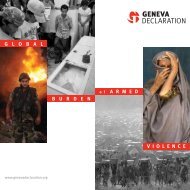Tackling Violence against Women: From Knowledge to Practical
Tackling Violence against Women: From Knowledge to Practical
Tackling Violence against Women: From Knowledge to Practical
Create successful ePaper yourself
Turn your PDF publications into a flip-book with our unique Google optimized e-Paper software.
22 label a survey, what the appropriate conditions for interviewing are, and how<br />
<strong>to</strong> maintain the absolute confidentiality of the data afterwards. Interviewers<br />
will need rigorous training <strong>to</strong> manage the surveying appropriately and enable<br />
them <strong>to</strong> cope with other ethical issues they are likely <strong>to</strong> face (wHO, 2001;<br />
Ellsberg and Heise, 2005).<br />
TAckliNG ViolENcE AGAiNsT WomEN<br />
Many of these issues also concern researchers on armed violence in a way<br />
that others do not. Armed violence assessments must carefully address<br />
specific ethical issues in interviewer selection and training as part of their<br />
design and implementation. Absolute confidentiality also applies when<br />
asking about gang violence in a particular neighbourhood or the weapons<br />
that households possess. when researching armed violence, guaranteeing<br />
the respondents’ and researchers’ safety is crucial. So, while a VAw module<br />
will require special preparation and training, researchers who work on sensitive<br />
issues such as armed violence, gang membership, or gun ownership often<br />
already have the orientation necessary for ethical and safe research conduct<br />
in this domain.<br />
The Small Arms Survey regularly conducts country-based household surveys<br />
<strong>to</strong> measure the scale and distribution of armed violence and its negative<br />
impact on development. The surveys also include assessments of VAw. 15<br />
Efforts <strong>to</strong> develop a methodological guide <strong>to</strong> conduct surveys on armed<br />
violence in an ethical manner are under way (Small Arms Survey, forthcoming).<br />
A VAw dimension in both general household surveys and stand-alone<br />
surveys represents a real gain for advancing knowledge on VAw. However,<br />
focused VAw research often lacks comparability in study design, limiting<br />
researchers’ ability <strong>to</strong> accumulate knowledge across studies and <strong>to</strong> evaluate<br />
possible changes in VAw forms and frequency. A well-designed module for<br />
national armed violence assessments needs <strong>to</strong> be developed that would<br />
yield baseline measures that could be re-evaluated consistently at a later<br />
date. It would also provide the means <strong>to</strong> make informed cross-national<br />
comparisons among the countries studied.<br />
3� develop improved costing <strong>to</strong>ols for estimating the<br />
effects of VaW on development<br />
Researchers have long been concerned with estimating the negative consequences<br />
of collective armed violence. In the early 20th century, economists<br />
sought <strong>to</strong> demonstrate whether investment and destruction arising from armed<br />
conflict had the potential <strong>to</strong> generate new efficiencies and release productive<br />
energies (gD Secretariat, 2008b, p. 91).









